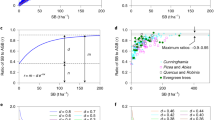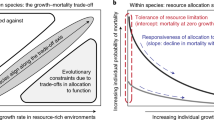Abstract
A prominent feature of comparative life histories is the well documented negative correlation between growth rate and life span1,2. Patterns of resource allocation during growth and reproduction reflect life-history differences between species1,2. This is particularly striking in tropical forests, where tree species can differ greatly in their rates of growth and ages of maturity but still attain similar canopy sizes3,4. Here we provide a theoretical framework for relating life-history variables to rates of production, dM/dt, where M is above-ground mass and t is time. As metabolic rate limits production as an individual grows, dM/dt ∝ M3/4. Incorporating interspecific variation in resource allocation to wood density, we derive a universal growth law that quantitatively fits data for a large sample of tropical tree species with diverse life histories. Combined with evolutionary life-history theory1, the growth law also predicts several qualitative features of tree demography and reproduction. This framework also provides a general quantitative answer to why relative growth rate (1/M)(dM/df) decreases with increasing plant size (∝M-1/4) and how it varies with differing allocation strategies5,6,7,8.
This is a preview of subscription content, access via your institution
Access options
Subscribe to this journal
Receive 51 print issues and online access
$199.00 per year
only $3.90 per issue
Buy this article
- Purchase on Springer Link
- Instant access to full article PDF
Prices may be subject to local taxes which are calculated during checkout


Similar content being viewed by others
References
Charnov,E. L. Life History Invariants: Some Explorations of Symmetry in Evolutionary Ecology (Oxford Univ. Press, Oxford, 1993).
Stearns,S. C. The Evolution of Life Histories (Oxford Univ. Press, Oxford, 1992).
Richards,P. W. The Tropical Rain Forest 2nd edn (Cambridge Univ. Press, Cambridge, 1996).
Chambers,J. Q., Higuchi,N. & Schimel,J. P. Ancient trees in Amazonia. Nature 391, 135–136 (1998).
Grime,J. P. & Hunt,R. Relative growth-rate: its range and adaptive significance in a local flora. J. Ecology 63, 393–422 (1975).
Tilman,D. Plant Strategies nd the Dynamics and Structure of Plant Communities (Princeton Univ. Press, Princeton, 1988).
Cebran,J. & Duarte,C. M. The dependence of herbivory on growth rate in natural plant communities. Func. Ecol. 8, 518–525 (1994).
Gleeson,S. K. & Tilman,D. Plant allocation, growth rate and successional status. Func. Ecol. 8, 543–550 (1994).
Ricklefs,R. E. Environmental heterogeneity and plant species diversity: an hypothesis. Am. Nat. 111, 376–381 (1977).
Grubb,P. J. The maintenance of species diversity in plant communities: the importance of the regeneration niche. Biol. Rev. 52, 107–145 (1977).
Denslow,J. S. Gap partitioning among tropical rain forest trees. Biotropica (Suppl.), 12, 47–55 (1980).
Williamson,G. B. Gradients in wood specific gravity of trees. Bull. Torr. Bot. Club 111, 51–55 (1996).
Hubbell,S. P. et al. Light-gap disturbances, recruitment limitation, and tree diversity in a neotropical forest. Science 283, 554–557 (1999).
West,G. B., Brown,J. H. & Enquist,B. J. A general model for the origin of allometric scaling laws in biology. Science 276, 122–126 (1997).
Enquist,B. J., Brown,J. H. & West,G. B. Allometric scaling of plant energetics and population density. Nature 395, 163–165 (1998).
West,G. B., Brown,J. H. & Enquist,B J. A general model for the structure and allometry of plant vascular systems. Nature 400, 664–667 (1999).
Peters,R. H. et al. The allometry of the weight of fruit on trees and shrubs in Barbados. Oecologia 74, 612–616 (1988).
Niklas,K. The allometry of plant reproductive biomass and stem diameter. Am. J. Bot. 80, 461–467 (1993).
Thomas,S. C. Reproductive allometry in Malaysian rain forest trees: biomechanics verses optimal allocation. Evol. Ecol. 10, 517–530 (1996).
Stevens,G. C. Lianas as structural parasites: the Bursera simaruba example. Ecol. 68, 77–81 (1987).
Whittaker,R. H. & Woodwell,G. M. Dimension and production relations of trees and shrubs in the Brookhaven Forest, New York. Ecology 56, 1–25 (1968).
Smith,D. W. & Tumey,P. R. Specific density and caloric value of the trunk wood of white birch, black cherry, and sugar maple and their relationship to forest succession. Can. J. For. Res. 12, 186–190 (1982).
Augspurger,C. K. Seed dispersal of the tropical tree Platyposdium elegans and the escape of its seedlings from fungal pathogens. J. Ecol. 71, 759–771 (1983).
Borchert,R. Soil and stem water storage determine phenology and distribution of Dry Tropical forest trees. Ecology 75, 1437–1449 (1994).
Sobrado,M. A. Aspects of tissue water relations of evergreen and seasonal changes in leaf water potential components of evergreen and deciduous species coexisting in tropical forests. Oecologia 68, 413–416 (1986).
Fearnside,P. M. Wood density for estimating forest biomass in Brazilian Amazonia. For. Ecol. Manage. 90, 59–87 (1997).
Janzen,D. H. Guanacaste National Park: Tropical Education, and Cultural Restoration (Editorial Univ. Estatal a Distanca, San Jose, 1986).
Niklas,K. J. Plant Allometry: The Scaling of Form and Process (Univ. Chicago Press, Chicago, 1994).
Harvey,P. H. & Pagel,M. D. The Comparative Method in Evolutionary Biology (Oxford Univ. Press, Oxford, 1991).
Malavassi,I. C. Maderas de Costa Rica: 150 Especies Forestales (Univ. de Costa Rica, San Jose, 1998).
Acknowledgements
We thank R. J. Whittaker, G. C. Stevens, D. H. Janzen, J. J. Sullivan, L. Brown, C. A. F. Enquist, A. Masis and the A.C.G. for comments and help with data collection. B.J.E. was supported by a NSF postdoctoral fellowship, G.B.W. by the US Department of Energy and the NSF, E.L.C. by a MacArthur fellowship and J.H.B. by a University of New Mexico Faculty Research Semester. B.J.E., G.B.W. and J.H.B. were also supported by the Thaw Charitable Trust.
Author information
Authors and Affiliations
Corresponding author
Rights and permissions
About this article
Cite this article
Enquist, B., West, G., Charnov, E. et al. Allometric scaling of production and life-history variation in vascular plants. Nature 401, 907–911 (1999). https://doi.org/10.1038/44819
Received:
Accepted:
Issue Date:
DOI: https://doi.org/10.1038/44819
This article is cited by
-
Evaluating the Development and Application of Stand Density Index for the Management of Complex and Adaptive Forests
Current Forestry Reports (2024)
-
Carbon storage and economic efficiency of fruit-based systems in semi-arid region: a symbiotic approach for sustainable agriculture and climate resilience
Carbon Research (2024)
-
Life history complementarity and the maintenance of biodiversity
Nature (2023)
-
Solving the grand challenge of phenotypic integration: allometry across scales
Genetica (2022)
-
The effect of plant–plant interactions as a key biotic process mediating the spatial variation of phenotypes in a Pinus sylvestris forest
Trees (2022)
Comments
By submitting a comment you agree to abide by our Terms and Community Guidelines. If you find something abusive or that does not comply with our terms or guidelines please flag it as inappropriate.



